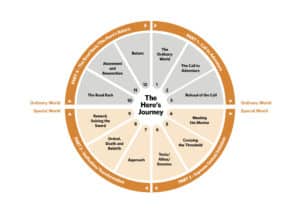The call to adventure: the journey to finding oneself.
— by Karl Tischler, Marlin Communications
About a year ago I completed the Australian Progress Advocacy Fellowship. It was perhaps one of the best things I’ve ever knowingly chosen to do. I’d decided to do this from a latent frustration that there must be other things that our donors and supporters can do to ensure progressive social change happens.
This decision was borne out of impatience and frustration; impatience that the kind and pace of social change I wanted wasn’t happening fast enough; and frustration that the pathways are mostly limited by what I was doing most—asking people for their financial support.
However, what I learned and what had the greatest impact on me was the power and utter persuasiveness of effective storytelling. Not superficial ‘fairy-tale’ storytelling, but storytelling in reference to a defined Public Narrative and a much deeper story of self.
What I realised was that such storytelling is the catalyst behind how we make decisions, how our values can be guided and ultimately how fundamental stories are to defining our sense of worth and who we are.
We are hard-wired for storytelling. Whether as children or adults, our personal identities, beliefs and values are all defined by the stories we hear, tell and engage with. Our memories—our societal and personal histories—are all influenced by the kinds of stories we immerse ourselves in.
A great story can bring people together, divide, impart knowledge and insight, entertain, inform or deceive. There’s the darkness and light of storytelling; the way we create horror, drama, joy and happiness. This is all through a story. The way we coax empathy and compassion for others’ pain. There’s the inspiration, the hope and fear of collective stories—narratives we tell to bind or divide a tribe. There’s the stories we tell to persuade others, galvanise collective support and seek action.
Yet this leads to a bitter irony and one of the things that I’ve struggled to understand; why, in the face of overwhelming facts, statistics and reason, do people choose not to believe in a problem or an issue that demands their attention and action?
Every client and every organisation that I’ve ever worked with has a great cause and reason for why they exist. Our sector has some of the greatest stories and content around—literally the stuff of life and death.
Many are unaware of this treasure that they sit upon—others seem to have lost an understanding of this. Despite this when I consider the above irony and what we are tasked to do—to persuade people to care and act—then we must begin by understanding how people make a decision. Because at some point all social change requires a decision to act.
Let’s go back a bit…
In the late 1960s, two academics—Amos Tversky and Daniel Kahneman—sought to understand how and why people make the kinds of decisions they do. At the time, the prevailing orthodoxy was determined by rational economics; that people seek to maximise their own marginal utility on the basis of access to information.
Yet, this didn’t explain the stupidity and irrationality behind many choices made.
Finally, amongst the many explanations—including some of the most well-known ideas such as ‘social proof’, ‘recency and confirmation bias’, ‘anchoring’, ‘loss framing’ etc.— Daniel Kahneman came to a simple and stunning conclusion; ‘No one ever made a decision because of a number. They need a story.’
We often believe in a story, not necessarily because it is true, but because it connects with our deeper values. Those values are largely defined by the way we are and raised the stories our parents tell us. This explains the stories that we are attracted to and seek to align ourselves with—these are what define us.
This is the true power of effective storytelling.
Our donors and supporters want to hear us tell stories. They want to be inspired and moved by great stories—and they want to define themselves by the causes and stories that they can see themselves in.
Above all, they want to feel something. They want to believe in something greater than themselves and their daily routine. They want to connect to what it is that makes us all human.
Everyone at some stage in their life seeks reassurance and meaning. Reassurance that they’ve made the right choices and that they didn’t waste their time. And I humbly posit, that we all seek meaning because the story we believe in is that everyone’s life must have a point.
If this is indeed true, then our sector has an abundance of meaning and purpose in the stories and causes that surround us. Causes that warrant our time and attention. Causes, which if we chose to align ourselves with, give as much to us and our definition of who we are, as to what they ask of us in return.
This is the power of a great story; that we can see ourselves in a shared story and derive meaning and purpose from it.
Understanding The Hero’s Journey.
If ‘storytelling’ is so fundamental to our humanity, then perhaps we should understand the story-telling structure a little more.
‘The Hero’s Journey’ was first popularised by Joseph Campbell in the late 1940’s. It’s based on the idea of a monomyth—or one meta-narrative that governs all story-telling, myths, tales and folklore. It has become a template of a broad category of stories that involves a hero who goes on an adventure, is faced by a challenging crisis that they must overcome and once they do, they win and then return home transformed.
It’s easy to spot in practise—however its scope is truly breathtaking when you consider that it can be applied to almost every story ever told, across cultures, across countries and across ages.
Think of; ‘Lord of the Rings’, ‘Star Wars’, ‘Don Quixote’, ‘Beowulf’, every Greek mythology tale from The Odyssey to Jason and the Argonauts, ‘The Lightning Thief’, ‘To Kill a Mockingbird…’, ‘Hearts of Darkness’— the list goes on, and on, and on.
As a meta-narrative, if you can appreciate the Hero’s Journey—and the underlying story structure of it—then you can predict emotional receptiveness, at what stage someone is at, and their propensity to make a decision.
Perhaps more importantly, you can use it to determine how you can best engage with your donors and supporters—and to what extent they see themselves as playing the kind of role you want in your story.
Here’s a diagram of ‘The Hero’s Journey’;
To illustrate how this works and what it means, let’s consider how ‘The Hero’s Journey’ structure plays out with regards to the Harper Lee’s novel, ‘To Kill a Mockingbird’…
The Ordinary World
Atticus Finch is a small-town lawyer in the American deep-south (Alabama) in the 1930’s
The Call to Adventure
He is asked to defend a black man, Tom Robinson, who is accused of raping a white woman.
Refusal of the Call
At first, he declines. He is reluctant to expose his children, Scout and Jem, to the cruelties that he knows underlie a bigoted society. He wants to protect their innocence—he is not ready to face a much larger battle; overcoming the morality and prejudices of the deep south.
Meeting the Mentor
Atticus’ children are looked after by Calpurnia—a black woman who is the family’s maid, cook and sometimes disciplinarian. She’s also the ‘conduit’ to her community. She is the helper. Yet the mentor is Miss Maudie—a principled, but simple woman who also believes, as Atticus does, in justice and speaks wisely with the children. Miss Maudie reflects Atticus sense of justice and decency.
Crossing the Threshold
The local judge appoints Atticus to defend Tom Robinson. Despite his initial reluctance, and knowing that the trial is a forgone conclusion, he agrees to defend Tom to the best of his ability. As the trial begins, the hostility towards Atticus and his children grows.
Tests, Allies and Enemies
Many people in town let their bigotry and racism come to the fore. It is a tense time where enemies are made, and unlikely allies formed.
Approach
Finally, Tom Robinson’s trial finishes. It is indeed the foregone conclusion that Atticus had expected. Everyone who believes in justice and the rule of law, is crushed. Jem’s faith in justice is badly shaken, and whilst Atticus is hopeful that he can get the verdict overturned, Tom is shot and killed while trying to escape from prison. Yet Scout’s journey hasn’t ended—she still faces the prejudices that her father’s involvement in the trial has unveiled…
Ordeal, Death and Rebirth
A while later and whilst walking home from a Halloween party, Scout and her brother Jem are attacked by the husband of the woman who falsely accused Tom, Bob Ewell. In the ensuing fight, Jem’s arm is broken. In steps the reclusive Boo Radley—a hermit type scared of the outdoors—to save them both. Tragically, as they fight, Boo kills Bob.
Reward, Seizing the Sword
Whilst Scout and Jem are saved, it is bittersweet.
The Road Back
Although their lives are saved, the greater lesson learned by Scout is a moral one. Her faith in the goodness of humanity is restored, especially by Boo, who risks his life.
Atonement and Resurrection
Sheriff Tate arrives and discovers Ewell dead from a knife wound. He rules that Bob Ewell died on his own knife, and plainly says, ‘Let the dead bury the dead…’
Return
Atticus believes that Jem was responsible but Sheriff Tate is certain it was Boo. The Sheriff’s decision not to convict Boo restores the children’s faith in what is right, and what is wrong. Atticus is not so sure, yet is persuaded when Scout explains that to send Boo to prison would be ‘like killing a mockingbird…’ The mockingbird is the great metaphor for innocence—and it is these words which confirm that Scout has indeed learned a great lesson and has come full circle in her journey.
As you can see, it’s a powerful, yet simple model.
However, its power increases when coupled with Public Narrative—or story of self.
Every person and organisation has a Public Narrative—it’s essence is providing a ‘why’ rationale that appeals to an audience’s values, and translating those into action via the stories told.
Such Public Narrative combines three main parts; a ‘story of self’—ie. why you’ve been called to serve—a ‘story of us’, ie. why your community is called to act (and why you in particular have the capacity to lead)—and a ‘story of now’ which communicates the urgent challenge we are called upon to face today.
All these ingredients are included within ‘The Hero’s Journey’—and all these ingredients are core to effective Public Narrative; we are called to make a choice, a choice for which we are unprepared, yet that choice yields an outcome, and that outcome teaches a moral.
This is what The Hero’s Journey leads us to; ourselves.
We often say that our sector’s reason for existing is to ‘make the world a better place’.
If that is indeed so, then it’s incumbent on every organisation in our sector to nail their public narrative and tell their strongest story. Because if you are unable to use your Public Narrative, to tell your story and how you want your audience to see themselves in your story, then what right do you have to ask them anything?



